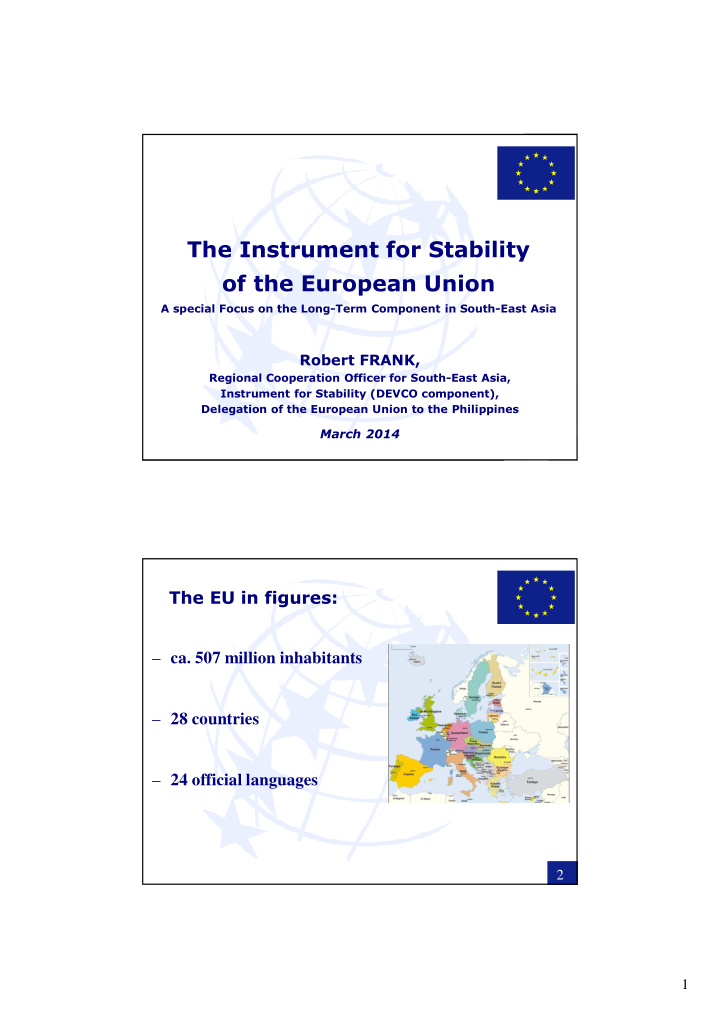



The Instrument for Stability of the European Union A special Focus on the Long-Term Component in South-East Asia Robert FRANK, Regional Cooperation Officer for South-East Asia, Instrument for Stability (DEVCO component), Delegation of the European Union to the Philippines March 2014 1 The EU in figures: – ca. 507 million inhabitants – 28 countries – 24 official languages 2 1
The EU in figures: – largest investor in the Philippines (€ 7.9 billion FDI stock in 2010, that is ca. 40% of total Philippine FDI stock) – largest investor in ASEAN countries (ca. € 9.1 billion annually) – EU = ASEAN’s 2 nd largest trading partner (11 % of ASEAN trade), ASEAN = EU's 3 rd largest trading partner (> € 206 billion in goods and services in 2011) 3 Key aims of the EU’s external policy: – support stability, promote human rights – and democracy, seek to spread prosperity, and – – support the enforcement of the rule of law and good governance. 4 2
Instruments for External Actions European Instrument Pre-Accession for Democracy and Instrument Human Rights European Instrument for Neighbourhood Nuclear Safety Instrument Development Instrument for Cooperation etc. Stability Instrument 5 The EU’s Instrument for Stability: – was launched in 2007 as Instrument for Stability, – had a financial envelope of more than € 2 billion for 2007 – 2013, – is expected to have more resources in the financial envelope 2014 – 2020. 6 3
“Peace, security and stability as well as human rights, democracy and good governance are essential elements for sustainable economic growth and poverty eradication.” IfS Regulation 2006 7 The Instrument for Stability has two components: Component for situations of crisis or emerging crisis ("short-term") Component for a context of stable conditions ("long-term") 8 4
The EU’s Instrument for Stability aims to help, in a situation of crisis or emerging crisis, preserve, establish or re-establish stability; Example: International Monitoring Team in Mindanao, Philippines 9 The EU’s Instrument for Stability aims to help, in the context of stable conditions, build capacity. 10 5
The Instrument for Stability in the context of stable conditions helps build capacity in the fields of addressing global and transnational threats CBRN risk mitigation preparedness for pre- and post-crisis situations 11 The EU’s Instrument for Stability aims to help, in the context of stable conditions, build capacity to ensure preparedness to address pre- and post-crisis situations; Example: Training in facilitation and mediation, Maldives 12 6
The EU’s Instrument for Stability aims to help, in the context of stable conditions, build capacity to address specific global and transregional threats having a destabilising effect; 13 Examples of global and transregional threats: – terrorism and organised crime, – illicit trafficking of people, drugs, firearms and explosive materials, – ineffective control of illegal trade and transit, – threats to international transport, energy operations and critical infrastructure, – threats to public health (e. g. epidemics, falsified medicines), – cybercrime. 14 7
EU capacity building actions to address global and transregional threats: EU-UNODC Joint Initiative for Supporting Southeast Asian Countries to Counter Terrorism − Cambodia, Laos, Indonesia, Philippines, Vietnam − € 2 million − 05/2012 - 04/2014 − supporting regional and national capacity to counter terrorism while fully respecting human rights and undertake related regional cooperation 15 EU capacity building actions to address global and transregional threats: Capacity Building on Hazardous and Noxious Substances Preparedness and Response in the Straits of Malacca and Singapore − Contribution to the International Maritime Organization Malacca and Singapore Straits Trust Fund − € 500.000,-- − 11/2010 – 11/2012 16 8
EU capacity building actions to address global and transregional threats: Critical Maritime Routes Programme Monitoring, Support and Evaluation Mechanism (CRIMSON) − in South East Asia: Indonesia, Malaysia, Singapore − € 1 million − 01/2013 – 01/2015 − strengthen the transregional coordination, coherence and complementarity effect among the various projects contained in the Critical Maritime Routes Programme 17 EU capacity building actions to address global and transregional threats: Critical Maritime Routes Indian Ocean (CRIMARIO) − Western Indian Ocean and South-East Asia − € 5.5 million − to be launched in 2014 − enhance information sharing between countries of the two regions and build capacity to increase transregional cooperation on maritime safety and countering piracy 18 9
EU capacity building actions to address global and transregional threats: Global Action on Cybercrime (GLACY) − in South-East Asia: Philippines (interested in implementing the Budapest Convention on Cybercrime) − € 3 million (EU contribution) − Nov. 2013 – Nov. 2016 − enable criminal justice authorities to engage in international cooperation on cybercrime and electronic evidence on the basis of the Budapest Convention on Cybercrime 19 The EU’s Instrument for Stability aims to help, in the context of stable conditions , build capacity to provide assistance to risk mitigation and preparedness relating to chemical, biological, radiological and nuclear (CBRN) materials or agents. 20 10
EU capacity building actions to provide assistance to risk mitigation and preparedness relating to CBRN materials or agents: Assistance in Export Control of Dual Use Goods − in South-East Asia: Malaysia, Philippines, Thailand, Vietnam − € 3,650,000.-- − 05/2013 - 12/2014 − Implemented by the German BAFA (Bundesamt für Wirtschaft und Ausfuhrkontrolle) 21 EU capacity building actions to provide assistance to risk mitigation and preparedness relating to CBRN materials or agents: EU CBRN Centres of Excellence Risk Mitigation Initiative 22 11
Website : http://www.cbrn-coe.eu/ 23 Contact: Regional Cooperation Officer for South-East Asia, Instrument for Stability (DEVCO): Robert FRANK Robert.Frank@eeas.europa.eu +63 2 859 5136 Delegation of the European Union to the Philippines 30/F Tower 2, RCBC Plaza 6819 Ayala Av., Makati City, 1200, Metro Manila 24 12
Thanks for your attention! 25 13
Recommend
More recommend